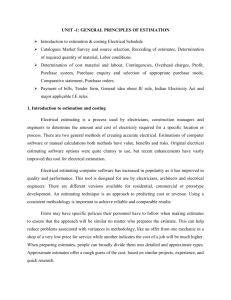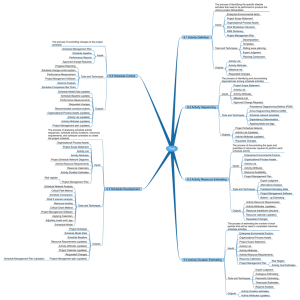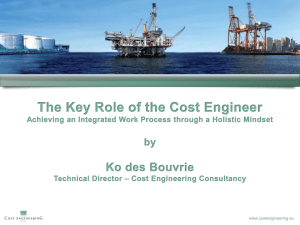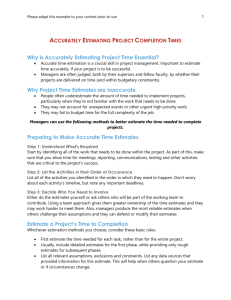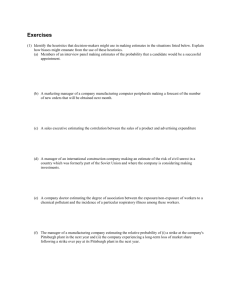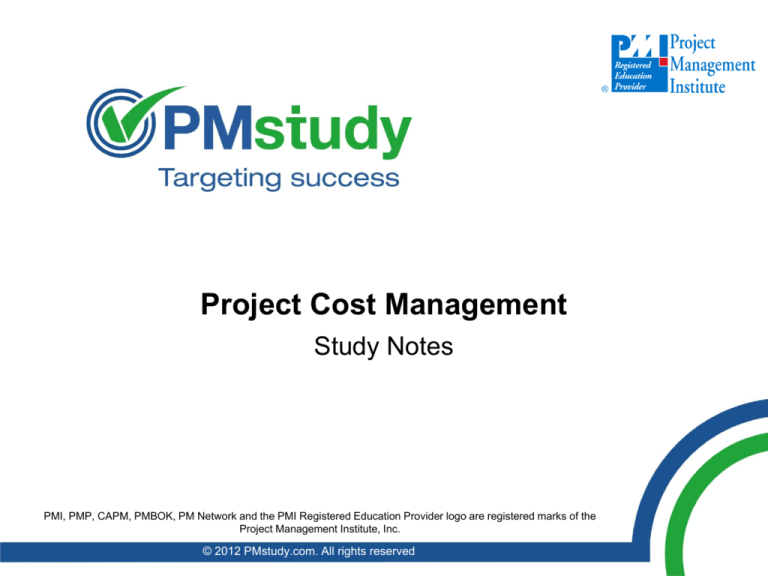
Project Cost Management
Study Notes
PMI, PMP, CAPM, PMBOK, PM Network and the PMI Registered Education Provider logo are registered marks of the
Project Management Institute, Inc.
© 2012 PMstudy.com. All rights reserved
Points To Note
• Please read Chapter 7 from Project Management Institute, A Guide to the Project
Management Body of Knowledge, (PMBOK® Guide) – Fourth Edition, Project Management
Institute, Inc., 2008 (pages 165-188)
• The study notes explain topics that are important for PMP® exam preparation, and you can
expect several questions from these topics.
• It is very important to understand all the concepts discussed in this chapter; so, please pay
close attention to all the terms used.
• Try to relate the concepts to real life examples.
• After reading the study notes, please answer the chapter test questions in this knowledge
area. The chapter questions improve your understanding of the concepts discussed in the
study notes.
© 2012 PMstudy.com. All rights reserved
2
What is Project Cost Management?
• Processes that help to estimate, budget, and control cost so as to ensure that the project is
completed within the approved budget.
• Processes primarily concerned with the cost of resources required to complete the project
activities.
• Processes associated with cost management include:
◦ Estimate Costs
◦ Determine Budget
◦ Control Costs
• Processes and related tools and techniques are usually selected when defining the project life
cycle and are documented in cost management plan.
Please refer to PMBOK® Guide Fourth Edition, page 167, figure 7-1. This provides an overview
of the processes in Project Cost Management.
© 2012 PMstudy.com. All rights reserved
3
Estimate Costs
• Process that develops an estimation of the monetary resources required to complete the
project activities.
• Cost estimates are a prediction based on the information known at a given point in time.
• Process that identifies and considers costing alternatives to initiate and finish the project.
• Process in which the accuracy of estimation of costs increases as the project progresses
through its life cycle.
• Process that makes a quantitative assessment of the likely costs of resources required to
finish the activity.
• Process outputs are:
◦ Activity cost estimates
◦ Basis of estimates
◦ Project document updates
• Differs from pricing: Pricing is what the seller charges for their products or services whereas
costs are what the manufacturer incurs for manufacturing those products or rendering those
services.
© 2012 PMstudy.com. All rights reserved
4
Estimate Costs – Tools and Techniques
• Expert Judgment
• Analogous Estimating
• Parametric Estimating
• Bottom-Up Estimating
• Three-Point Estimates
• Reserve Analysis
• Cost Of Quality (COQ)
• Project Management Estimating Software
• Vendor Bid Analysis
For details, please refer to PMBOK® Guide Fourth Edition, pages 171-173
© 2012 PMstudy.com. All rights reserved
5
Analogous Cost Estimating
(Top Down)
• Uses the actual cost of a previous, similar project as the basis for estimating the cost of the
current project
• Frequently used to estimate total project costs when there is a limited amount of detailed
information about the project
• Uses historical information and expert judgment
• Generally is less costly than other techniques
• Is less accurate and time consuming
• Can be applied to a total project/segment of a project
• Provides reliable information when:
◦ Previous projects are similar in fact and not just in appearance.
◦ Project team members preparing the estimates have the needed expertise.
© 2012 PMstudy.com. All rights reserved
6
Bottom-Up Estimating
• Estimates the cost of individual activities or work packages with the greatest level of specified
detail.
• Summarizes by rolling up the individual estimates to get a project detail.
• Summarizes or rolls up detailed costs to higher levels for further reporting and tracking.
• The level of accuracy and the cost estimate varies, depending on the size and complexity of
the individual activity or work package.
© 2012 PMstudy.com. All rights reserved
7
Parametric Estimating
• Uses a statistical relationship between historical data and other variables to calculate the
estimation of activity parameters
• Produces higher levels of accuracy based on the data and the sophistication built into the
model
• Can be applied either to a total project or to segments of a project, in conjunction with other
estimating methods
© 2012 PMstudy.com. All rights reserved
8
Three-Point Estimates
• Analytic technique that uses three cost or duration estimates to represent the optimistic, most
likely, and pessimistic scenarios.
• Optimistic, most likely, and pessimistic estimates clarify the range of uncertainty of the cost
estimates.
• Technique helps in improving the accuracy level of the cost or duration estimates, when the
underlying activity or cost component is uncertain.
• Originated with PERT (Program evaluation and review technique). PERT uses this method of
estimating to define the range for an activity’s cost.
© 2012 PMstudy.com. All rights reserved
9
Activity Cost Estimates
• Quantitative assessments of the probable costs required to complete project work
• Can be in summary form or in detail
• Estimating the costs for all resources –direct labor, materials, equipment, services, facilities,
information technology, and special categories such as an inflation allowance, and cost
contingency reserve
• Indirect costs, if included in the project estimation, are included at the activity level or higher
levels
© 2012 PMstudy.com. All rights reserved
10
AACE – Types of Estimates
• AACE has identified five types of estimates of construction costs during Engineering
◦
Order of Magnitude
◦
Conceptual
◦
Preliminary
◦
Definitive
◦
Control
Estimate
% Variance
Order Of Magnitude
- 50% to +50%
Budgetary Estimates
- 15% to +25%
Definitive Estimates
- 5% to +10%
© 2012 PMstudy.com. All rights reserved
11
Determine Budget
• Process of aggregating the estimated costs of individual activities or work packages to
establish an authorized cost baseline.
• This baseline includes all authorized budgets, but excludes management reserves.
• Project budgets constitute the funds authorized to execute the project.
• Outputs of this process are:
◦ Cost Performance Baseline
◦ Project Funding Requirements
◦ Project Document Updates
© 2012 PMstudy.com. All rights reserved
12
Project Schedule and Resource Calendars
Project Schedule:
• Part of the project management plan.
• Includes planned start and expected finish dates for the project’s various components like
activities, milestones, work packages, etc. This information is used to aggregate costs to the
calendar periods in which the costs are planned to be incurred.
Resource Calendars:
• Provides information on which resources are assigned to the project and when they are
assigned. This information can be used to indicate resource costs over the duration of the
project.
© 2012 PMstudy.com. All rights reserved
13
Cost Performance Baseline
• An authorized time-phased budget at completion (BAC) used to measure, monitor, and control
overall cost performance on the project.
• Developed by summing up the approved budgets by time period and is typically displayed in
the form of an S-curve.
• In the earned value management (EVM) technique, the cost performance baseline is known as
performance measurement baseline (PMB). For example, a spending plan or cash flow
forecast is a cost baseline for measuring disbursements.
© 2012 PMstudy.com. All rights reserved
14
Revised Cost Estimates, Budget Updates,
Re-baselining
• Revised cost estimates
◦ Modification to the cost information used to manage the project
◦ May or may not require adjustments to other aspects of the project plan
• Budget updates
◦ Special category of revised cost estimates
◦ Changes to an approved cost baseline
• Re-baselining
◦ Process of redefining the cost performance/schedule/performance measurement/technical
baseline.
◦ If cost variances are very severe, re-baselining will be done to provide a realistic measure
of performance.
© 2012 PMstudy.com. All rights reserved
15
Control Costs
• Monitor the status of the project to update the project budget and manage changes to the cost
baseline.
• Any increase to the authorized budget can only be approved through the Perform Integrated
Change Control process.
• Cost control efforts involve analyzing the relationship between the funds that have been
utilized and the physical work accomplished for such expenses.
• For effective cost control, one must be able to manage the approved cost performance
baseline and the changes to that baseline.
• Outputs are:
◦ Work Performance Measurements
◦ Budget Forecasts
◦ Organizational Process Assets Updates
◦ Change Requests
◦ Project Management Plan Updates
◦ Project Document Updates
For more details, please refer to PMBOK® Guide Fourth Edition, pages 179-188
© 2012 PMstudy.com. All rights reserved
16
Control Costs – Tools and Techniques
• Earned Value Management (EVM)
◦ Commonly used method to measure performance.
◦ The EVM principle is applicable to all projects, in all industries.
• Planned Value (PV): Authorized budget assigned to work to be completed
• Earned Value (EV): Value of work performed expressed in terms of the approved budget
assigned to that work
• Actual Cost (AC): Total cost actually incurred in doing the work required for an activity
• Forecasting
◦ Estimating or predicting conditions and events in the project’s future based on information
and knowledge available at the time of the forecast.
• To-Complete Performance Index (TCPI)
◦ The calculated projection of cost performance that has to be achieved on the remaining
work in order to meet a specified management goal, such as the BAC or the EAC.
© 2012 PMstudy.com. All rights reserved
17
Control Costs – Tools and Techniques
(continued...)
• Performance Reviews
◦ It compares cost performance over time, schedule activities or work packages overrunning
and under running the budget, and estimated funds needed to complete work in progress.
• Variance Analysis
◦ A method of resolving the total variance in the set of scope, cost, and schedule variables
into specific component variances associated with defined factors affecting scope, cost, and
schedule variables.
• Project Management Software:
◦ Used to monitor PV, EV, and AC so as to display graphical trends.
© 2012 PMstudy.com. All rights reserved
18

